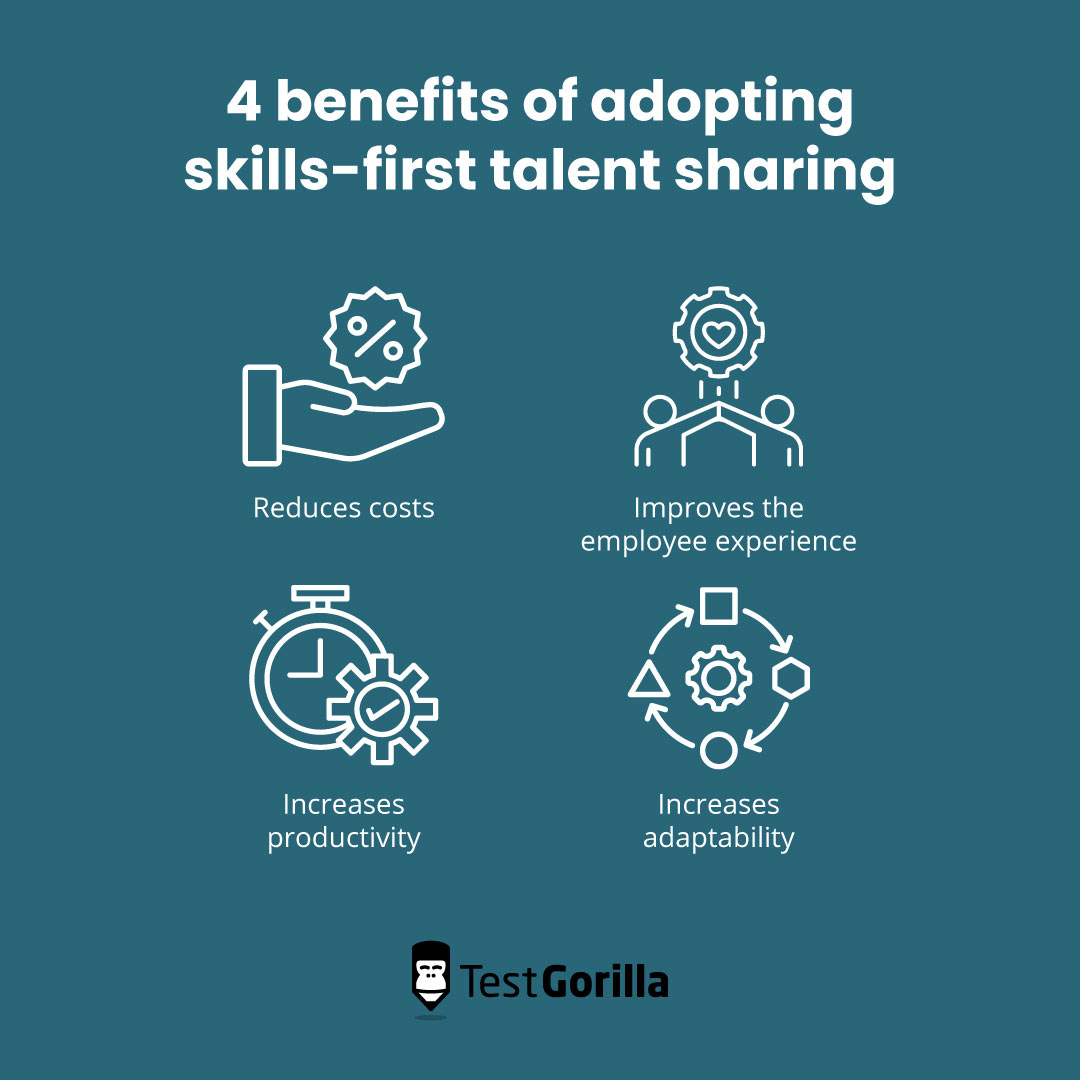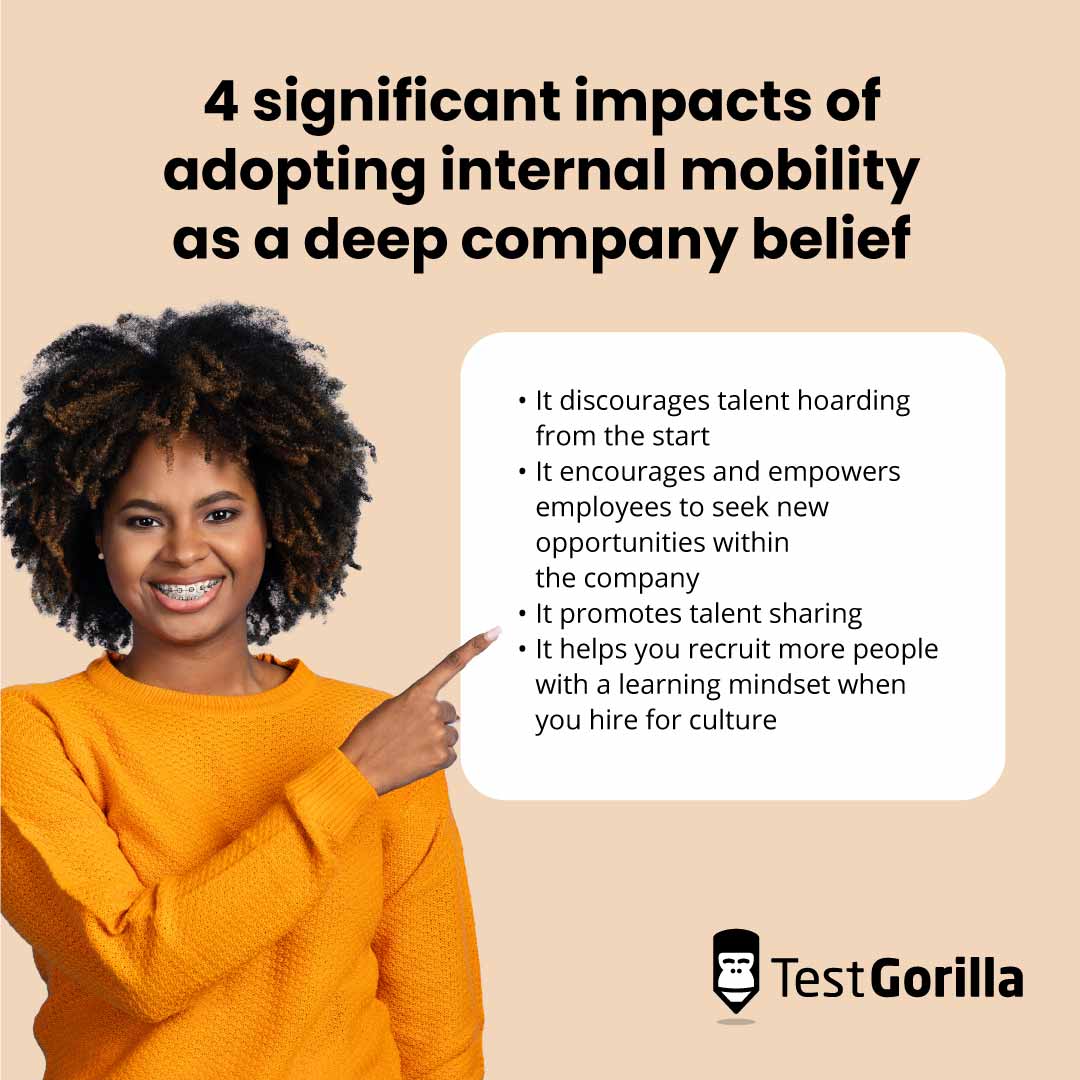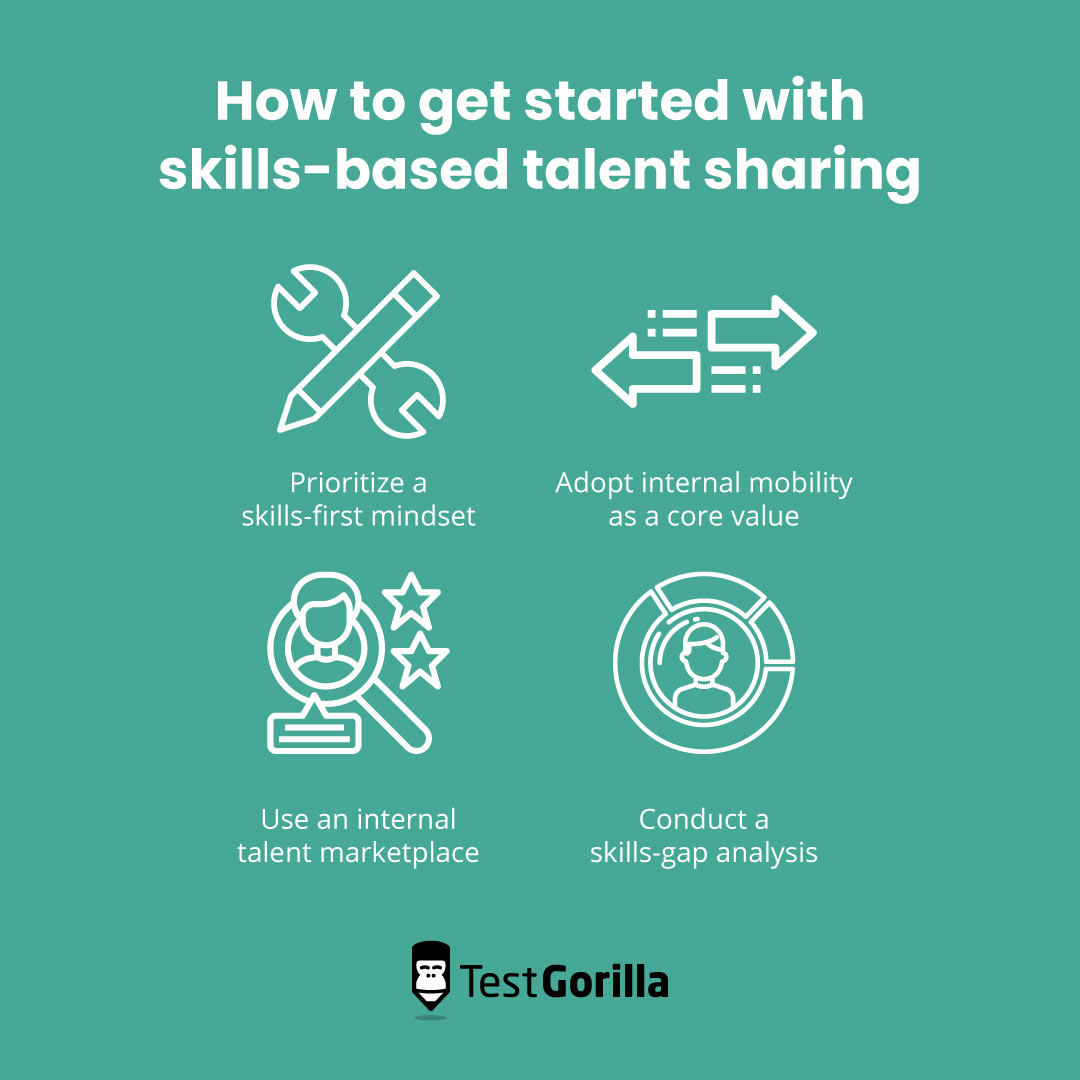The relationship between skills-based hiring and talent sharing
Increasingly more HR professionals are feeling pressure from events like the pandemic and the Great Discontent.
Organizations need top talent, and top talent is scarce.
A simple solution to this growing problem is out there: talent sharing.
Talent sharing is when a company shares employee skills across departments and teams, or possibly with a separate organization.
It’s an agile strategy that enables hiring managers to find the skills they need, and it also gives new career opportunities to employees, boosting motivation and retention.
Talent sharing is an excellent tactic for HR departments, but it works best with a skills-first mindset.
What’s the connection between skills-based hiring and talent sharing? This article examines their commonalities and how one facilitates the other.
Table of contents
- What is talent sharing?
- What are the benefits of talent sharing in 2023 and beyond?
- Is talent sharing easier in a skills-based organization?
- What are the benefits of combining talent sharing and skills-based practices?
- How to get started with skills-based talent sharing
- Tap into existing skills with talent sharing
What is talent sharing?
Talent sharing is the concept of sharing employee skills across teams, departments, geographies, and subsidiaries. It promotes the value of professional growth and job rotation while enabling different departments to benefit from mobile talent.
The practice of talent sharing breaks down a traditional hierarchy of rigid job roles and empowers managers to share their people’s talent with other departments, as well as receive talent from other departments to help their own.
Talent sharing is the polar opposite of talent hoarding, which is an unfortunately common trend in the working world right now.
Talent hoarding is when managers purposefully hold their people back from growth to ensure they don’t leave the team.
This practice stalls employee growth, which not only reduces worker satisfaction and increases employee turnover but also damages the organization as a whole.
About half of all managers resist any type of internal mobility, but the figure rises to 74% in lower-performing companies.[1]
Talent sharing is the solution to talent hoarding. It encourages internal mobility, helps fill skills shortages, and expands your talent pool.
The concept of talent sharing promotes employee growth and mobility, and it also helps during unprecedented events and crises.
"Employees have skills, experiences, passions, and interests that go beyond what they do in their day-to-day role. They are capable of contributing to the organization's success in unique ways. Employers need to find a way to offer opportunities and agency for them to opt into projects of interest." - Edie Goldberg, PhD founder and president of E.L. Goldberg & Associates
For example, the option to share talent helped alleviate pressure during the pandemic when companies were able to transfer food service roles (which were declining in demand) to hand sanitizer factory roles. But we’ll talk about that in-depth next.
What are the benefits of talent sharing in 2023 and beyond?
Talent sharing is the solution to many current issues, including the ongoing skills shortage and attrition from the Great Reshuffle.
The act of talent sharing facilitates quick and efficient access to high-demand skills. It makes getting the talent you need easier and more affordable without extra hiring initiatives or rushing for a quick fix, like contingent workers.
During the current talent crisis, it’s imperative for organizations to take advantage of the skills they already have in their workforce.
This enables you to fill talent gaps within your teams and allows workers to learn new skills, grow their careers, and make new connections.
For example, a programming team is given a new project requiring PHP coding skills. They quickly realize only two members of the team have these skills.
They reach out cross-departmentally and find five employees interested in the project. The team now has enough programmers to complete the project, and the new teammates have a chance to expand their reach and gain new experience.
Supporting talent mobility at Unilever
Talent sharing also makes it simpler for organizations to respond to sudden change. A famous example is Unilever, a multinational consumer goods company, and its response to the pandemic.
Unilever moved 9,000 employees from one job to another in only eight to 10 weeks because of the COVID-19 pandemic. Its food service departments were being drastically cut, but its hand sanitizing solutions had to grow exponentially.
By transferring this talent, Unilever solved its own skills shortage and provided employees with opportunities, limiting potential layoffs.
Talent sharing was essential to this company during the pandemic, and the sooner other organizations adopt the process, the better equipped they’ll be for the future.
Unilever is fervent that it’s only because they had started talent sharing the previous year that they were able to respond to the pandemic so well.
Disney and Siemens: Creating an ecosystem for talent sharing
An even more agile example of talent mobility comes from Siemens. An established leader in the manufacturing of medical devices, Siemens was known for the quality of its equipment, but the company wanted to take things a step further and create a truly patient-centric brand.
To help create a more compelling proposition for patients, Siemens drafted in talent from long-time partner Disney to improve the presentation of their products. Notably, staff from Disney created storybooks that tied in with Siemens' hearing aid devices for children. These books helped children understand the purpose of the medical device and become more comfortable using them.
After the initial success of the initiative, Siemens collaborated with talent from Disney to create multiple additional storybooks that guided young patients through a variety of other healthcare diagnostic-related challenges.
Sysco and Kroger: talent redistribution
Food distribution service Sysco demonstrated another great example of talent sharing and redistribution. Due to COVID-19 lockdowns, thousands of food service workers at the company were furloughed. At the same time, retail store Kroger was facing intense supply chain challenges due to the increase in demand for grocery items and other home products.
Recognizing an opportunity to share talent and efficiently redistribute workforces, Sysco signed an agreement with Kroger to enable temporarily furloughed employees to work at Kroger supermarket locations for 30 days or more.
In the end, both companies benefitted, and Sysco's workforce was able to develop additional skills without worrying about further lockdowns.
“This agreement will benefit many of Sysco’s associates by creating good work opportunities with a respected company, while at the same time helping to alleviate strain in the food supply chain due to a surge in demand at retail stores." - Kevin Hourican, president and chief executive officer of Sysco
The best insights on HR and recruitment, delivered to your inbox.
Biweekly updates. No spam. Unsubscribe any time.
Is talent sharing easier in a skills-based organization?
So what’s the connection between talent sharing and skills-based practices? Is talent sharing easier in a company with a skills-based approach to hiring, upskilling, and internal mobility?
The short answer is yes, but let’s take a deeper look.
Talent sharing requires looking at a company as a collection of skills instead of rigid job roles. For example, you don’t look at an employee as simply an “accountant.” You view them as a person who possesses great math skills, attention to detail, and financial skills.
This is what skills-based organizations do naturally. Each worker is viewed as a collection of skills that can fluidly move between the responsibilities they have the capability to complete.
This means skills-based organizations instill the mindset that talent isn’t a limited resource managers have to hoard. Talent is an abundant resource for the entire company to benefit from.
This mindset also promotes learning and development.
Skills-based practices facilitate and encourage continuous improvement, so talent sharing can also bridge talent gaps through cross-departmental training and coaching.
A focus on learning and development is crucial for modern workers. Upskilling and reskilling opportunities are no longer optional for candidates – they’re necessary.
The American Upskilling study found 65% of workers say employer-provided upskilling is very important when evaluating a new job, and nearly half (48%) say they would switch to a new job if it offered them opportunities to enhance their skills.
A focus on skills and development is one of the reasons why 91.2% of companies that use skills-based hiring saw an increase in retention in 2022.
Higher retention is another factor that facilitates talent sharing. Your organization doesn’t lose its employees’ skills and, therefore, has a larger pool to pull from whenever it needs extra talent.
Skills-based practices and talent sharing share so many of the same base values; it’s almost like they were made to go together.
What are the benefits of combining talent sharing and skills-based practices?
Skills-based practices and talent sharing mesh together in many ways. Both focus on skills and aim to put employees in the best possible place based on their skill sets.
This process solves skills shortages, empowers employee growth, and promotes adaptability.
Here are a few benefits of adopting skills-first talent sharing:
Reduces costs: Encouraging internal mobility and dynamically using current employee skills reduce the need for external hiring initiatives, which can be substantially more expensive
Improves the employee experience: Empowering employees to explore different teams and departments gives them more chances for growth and learning
Increases productivity: Looking inward for skills and capabilities gets work done more quickly and more efficiently
Increases adaptability: Adapting to a talent sharing mindset prepares organizations for sudden change and enables them to increase their agility
Let’s discuss this last point in depth.
Combining talent sharing and skills-based practices helps companies become more agile in a hyper-dynamic environment. Focusing on what an employee can do and moving them from task to task based on capability helps you solve unforeseen issues and respond to change.
One survey found 78% of respondents said it’s important for a company’s talent practices and processes to be designed to nurture employee agility and adaptability, but only 52% said they’re taking action to make it happen.
This is why skills-based practices are a crucial part of the future of HR. The rise of AI and a myriad of unprecedented events have changed work as we know it – and will continue to do so.
Prioritizing skills and moving workers to whichever project needs them most is invaluable when the skills you need as a business keep changing.
Adopting talent sharing and skills-based hiring helps you develop a healthy organizational mindset, particularly for your managers.
Managers are usually the ones responsible for talent hoarding, but it isn’t exactly their fault. A typical organization is structured so that talent hoarding is the only way for managers to stay successful and competitive.
But with this new mindset, managers accomplish more projects more quickly and with less expense, all the while retaining more employees – employees who have gained new skills and have had more experiences for growth.
These employees also bring fresh perspectives, new ideas, and innovative thinking back to their teams.
The integration of skills-first talent sharing helps the company as a whole. The more you distribute skills, the more everyone develops, which increases overall internal capability.
How to get started with skills-based talent sharing
Implement skills-first talent sharing in your organization by trying out our top best practices.
We recommend prioritizing internal mobility, taking advantage of current tech and tools, mapping out your workforce’s skills, and adopting a skills-based mindset.
Here’s a quick summary:
Prioritize a skills-first mindset
Adopt internal mobility as a core value
Use an internal talent marketplace
Conduct a skills-gap analysis
1. Prioritize a skills-first mindset
Skills-based hiring is the future of employment. It enables hiring managers to focus on what truly matters in a candidate: the skills to get the job done.
This practice helps you document your workforce’s skills and capabilities, which in turn gives you greater insights into talent sharing opportunities and areas for upskilling and reskilling.
Using skills tests, you can even specifically hire employees who are more adaptable and agile in response to change. For example, our DISC personality test gauges a candidate’s adaptability and steadiness.
Along with skills-based hiring, we also recommend a greater shift toward a total skills-based organization.
A skills-based organization views its workers as a collection of skills and competencies, which means it makes all its decisions based on skills.
Focusing on skills over connections or work history helps build a mindset where you hire, train, and promote based on capabilities. This makes it second nature to look inward if a role suddenly appears or disappears.
2. Adopt internal mobility as a core value
Internal mobility is the act of an employee moving to a new role within an organization, using either a vertical or lateral career path.
What’s more, internal mobility doesn’t just have to be a practice – it can be a core value.
When you adopt internal mobility as a deep company belief, it has a significant impact:
It discourages talent hoarding from the start
It encourages and empowers employees to seek new opportunities within the company
It promotes talent sharing
It helps you recruit more people with a learning mindset when you hire for culture
This last point is especially important.
When your organization openly embraces internal mobility, it also tells candidates what to expect from the start. New managers will be welcomed into the company knowing about talent sharing from day one, and employees will anticipate it.
You can even incorporate your stance on internal mobility into your Culture Add test to recruit individuals who have similar values surrounding learning and talent sharing.
3. Use an internal talent marketplace
We’ve discussed how you prepare your workforce for talent sharing mentally, but what about the technical side?
How do you facilitate talent sharing and make the process quick and easy for your workers?
Just like everything in the future, there’s a tool for that.
Internal talent marketplaces are a database of employee skills, competencies, and possible opportunities. They enable employees to post their skills and which roles they’re shooting for, and they also help workers browse for internal opportunities.
These tools are also driven by data, so employees get recommendations for positions related to their skills and aspirations.
They also make the process of talent sharing and internal mobility easier on managers by helping them find better opportunities for current team members or allowing them to efficiently check employee qualifications for an open role.
Internal talent marketplaces are gaining traction quickly. In fact, this type of tool is what Unilever uses to assist its talent sharing practices in the case study mentioned earlier.
4. Conduct a skills-gap analysis with skills tests
So how do you know which employees are suitable for talent sharing?
If you have an available project and several employees offer their assistance, how do you know if they’re suitable for it?
Conducting a skills-gap analysis helps you know which skills your employees possess and which projects they are a match for.
This process involves evaluating employees or teams with skills tests to assess their capability levels and find talent gaps. This helps you log current employee skills in your skills database, and it also helps inform future hiring efforts.
For example, a skills-gap analysis tells you that your team is short on Kotlin coding skills, so you post an opening in your internal talent marketplace for that capability.
A skills-gap analysis is an objective, data-driven method to discover employee skills and capabilities, so you can confidently place employees into new roles and projects.
Tap into existing skills with talent sharing
Talent sharing isn’t just a great modern strategy; it’s essential in this tumultuous era we live in.
The ability to fluidly fill positions and benefit from existing employee skills helps organizations reduce costs, stay agile, and improve the employee experience.
Get started by adopting internal mobility as a core value, assessing your workforce with a skills-gap analysis, and prioritizing a skills-first mindset throughout your entire company.
Talent sharing is a smart strategy because it’s more than finding top talent – you’re also making efficient use of what’s already inside your business.
Ready for the next step? Learn more about conducting a skills-gap analysis in our guide on how to use skills tests to address internal skills gaps.
To browse our database of more than 300 pre-employment tests, check out our test library.
Source
Lykins, Lorrie. (April 13, 2016). “Talent Mobility Matters”. i4cp. Retrieved June 16, 2023. http://i4cp.com/surveys/talent-mobility-matters
You've scrolled this far
Why not try TestGorilla for free, and see what happens when you put skills first.

















